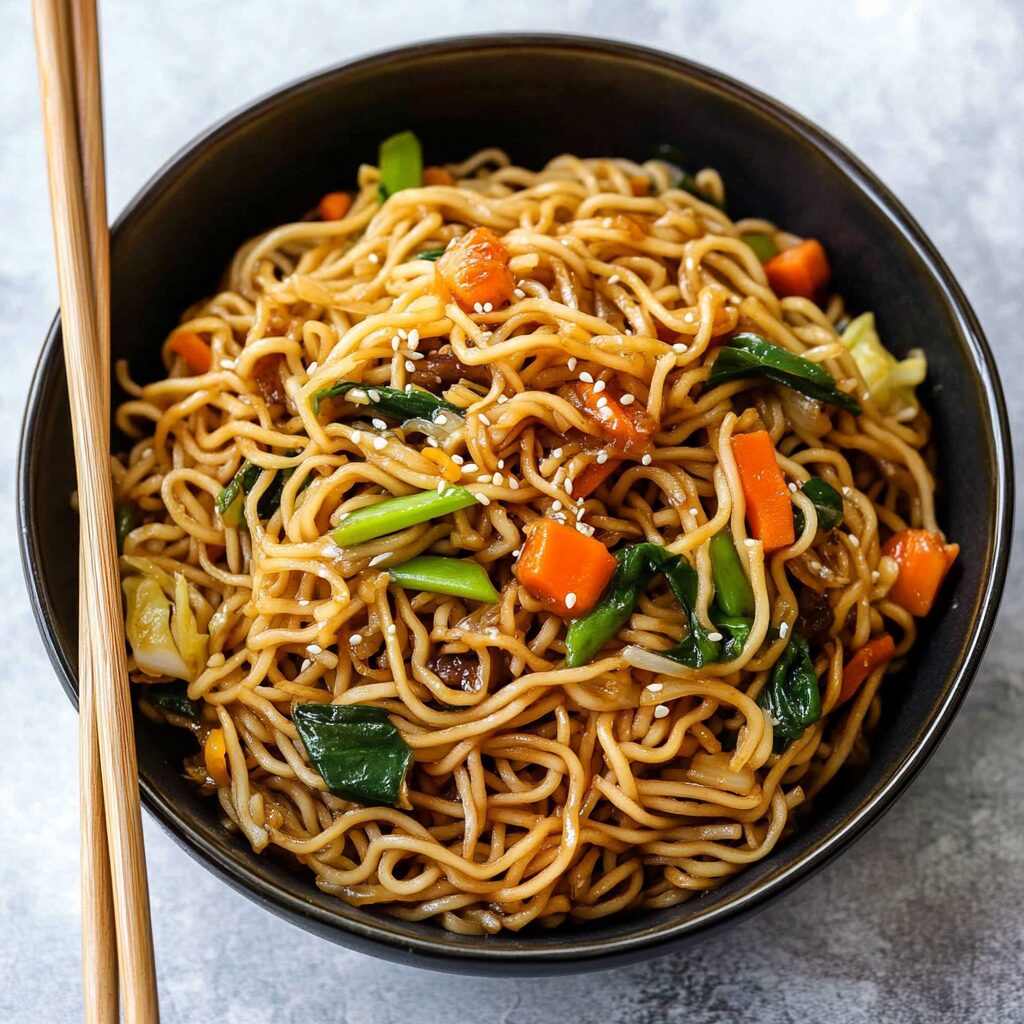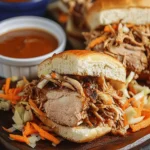This homemade Chinese Chow Mein is a quick and delicious stir-fry made with tender noodles, fresh vegetables, and a savory sauce. It’s a versatile dish that can be customized with your favorite protein, from chicken to tofu, making it a perfect weeknight meal or dinner option.
FULL RECIPE:
Ingredients:
- 8 oz chow mein noodles
- 1 tablespoon vegetable oil
- 1 cup cabbage, shredded
- 1/2 cup carrots, julienned
- 1/2 cup bean sprouts
- 1/2 cup bell peppers, thinly sliced
- 2 cloves garlic, minced
- 1/2 teaspoon ginger, grated
- 1/2 cup green onions, sliced
- 1 cup cooked chicken (or tofu for a vegetarian version)
For the Sauce:
- 1/4 cup soy sauce
- 1 tablespoon oyster sauce
- 1 teaspoon sesame oil
- 1 teaspoon sugar
- 1 teaspoon cornstarch
- 1/4 cup chicken broth
Directions:
- Cook chow mein noodles according to package instructions, then drain and set aside.
- In a small bowl, whisk together soy sauce, oyster sauce, sesame oil, sugar, cornstarch, and chicken broth.
- Heat vegetable oil in a large wok or skillet over medium-high heat.
- Add garlic and ginger, stir-fry for 30 seconds until fragrant.
- Add cabbage, carrots, bean sprouts, and bell peppers. Stir-fry for 2-3 minutes until slightly tender.
- Add cooked chicken (or tofu) and green onions, tossing to combine.
- Pour the sauce over the vegetables and protein, stirring well.
- Add the cooked chow mein noodles and stir-fry everything together for 2-3 minutes until well coated in sauce.
- Serve hot and enjoy!
Nutrients:
- Prep Time: 10 minutes
- Cooking Time: 15 minutes
- Total Time: 25 minutes
- Kcal: 320 kcal per serving
- Fat: 12g
- Carbohydrates: 45g
- Protein: 14g
- Fiber: 4g
- Sugar: 7g
- Sodium: 600mg
- Servings: 4
What Makes This Recipe Special
One of the reasons Chow Mein is such a beloved dish is its balance of textures and flavors. The noodles, after being stir-fried, take on a slightly crispy exterior while remaining tender inside, creating an ideal texture contrast. The sauce, typically a combination of soy sauce, oyster sauce, and sesame oil, gives the dish a deep umami flavor that ties everything together. Adding fresh vegetables not only enhances the dish’s visual appeal but also contributes to a slight crunch, making it both flavorful and refreshing. Unlike many takeout dishes, this recipe allows you to control the amount of salt, oil, and sugar, giving you a healthier alternative without sacrificing flavor. The choice of protein can also be adjusted to suit dietary preferences, whether you prefer chicken, beef, shrimp, or a plant-based option like tofu.
Key Ingredients and Their Role in the Dish
The primary ingredients in Chow Mein are relatively simple, but each plays an important role in creating the balanced flavors and textures the dish is known for. The chow mein noodles are the star of the dish. They are typically boiled and then stir-fried, which gives them their signature texture. While traditional Chow Mein calls for fresh noodles, dried noodles can be used as a more convenient alternative. The sauce, which is made from soy sauce, oyster sauce, sesame oil, and a bit of sugar and cornstarch, adds a rich, salty, and slightly sweet flavor that complements the noodles perfectly. Soy sauce brings the saltiness, while oyster sauce imparts a deep umami taste, and sesame oil adds a subtle nuttiness.
How to Perfect Your Chow Mein
The key to a successful Chow Mein lies in the technique and timing. Stir-frying is the cooking method of choice, as it allows the ingredients to cook quickly over high heat, which is essential for achieving the perfect texture. Here are a few tips to help you master your Chow Mein:
- Use a Wok or Large Skillet: A wok is ideal for stir-frying as it provides high, even heat, which is essential for getting the right texture on the noodles and vegetables. If you don’t have a wok, a large skillet will work just as well.
- Cook Noodles Separately: To ensure the noodles don’t become too soggy or clump together, cook them separately and then add them to the stir-fry towards the end of the cooking process. This allows them to stay firm and maintain their texture.
- Prep All Ingredients Before Cooking: Stir-frying is a quick process, so it’s crucial to have all your ingredients ready to go. Chop the vegetables, mince the garlic, and have your sauce mixture prepared in advance.
- High Heat is Key: Stir-fry the ingredients over high heat to ensure that the noodles and vegetables cook quickly without becoming too soft. This high heat also helps achieve the desirable slight crispness on the noodles.
- Adjust the Sauce: If you prefer a stronger flavor, feel free to adjust the sauce ingredients. Adding more soy sauce or sesame oil can give the dish a richer taste, while a splash of rice vinegar can add some acidity and balance out the sweetness.
Popular Variations of Chow Mein
While the traditional Chow Mein recipe is delicious on its own, there are numerous variations of the dish depending on the region and personal preferences. Here are a few popular options:
- Chow Mein with Beef: Instead of chicken or tofu, thinly sliced beef can be used as the protein. Beef adds a rich, savory flavor to the dish, making it a heartier option.
- Shrimp Chow Mein: For seafood lovers, shrimp is a great substitute for chicken. The shrimp adds a delicate sweetness and works well with the sauce and vegetables.
- Vegetarian Chow Mein: A completely meat-free version can be made by using tofu or just extra vegetables. The tofu can be either fried or sautéed to add some texture and protein to the dish.
- Crispy Chow Mein: In some restaurants, you may find a version of Chow Mein where the noodles are fried until crispy, creating a crunchy texture. This variation is often served with a small amount of sauce poured on top, allowing the noodles to remain crispy.
Serving Suggestions
Chow Mein is typically served as a main dish, but it can be paired with various sides to create a more complete meal. Here are some ideas for sides that go well with Chow Mein:
- Spring Rolls: Crispy spring rolls filled with vegetables or meat are a great appetizer to serve alongside Chow Mein.
- Egg Rolls: Another popular appetizer, egg rolls are filled with meat or vegetables and deep-fried to a crispy golden perfection.
- Chinese Dumplings: Dumplings filled with pork, chicken, or vegetables provide an extra dimension of flavor to your meal.
- Stir-Fried Vegetables: A simple stir-fry of additional vegetables, like broccoli or bok choy, complements the dish and adds more greens to the meal.
- Hot and Sour Soup: This flavorful soup is a great way to start the meal and pairs perfectly with the savory flavors of Chow Mein.
Conclusion
Chinese Chow Mein is a flavorful and versatile dish that can be easily adapted to suit different tastes and dietary needs. Whether you’re looking for a quick weeknight meal or a satisfying dinner to serve to guests, Chow Mein fits the bill. By following simple techniques and using fresh ingredients, you can create a delicious homemade version of this popular Chinese takeout dish. It’s a perfect balance of textures, flavors, and nutrients, making it a go-to for anyone craving comfort food with a twist.






